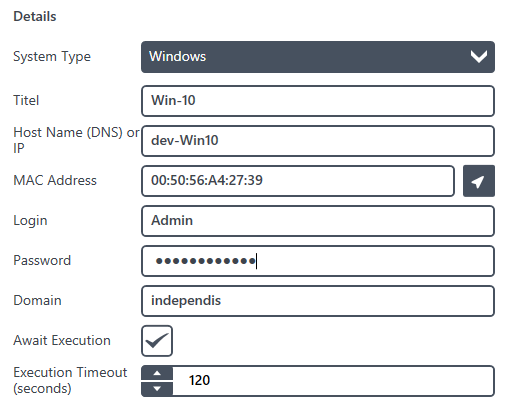Requirements
For OPMONis to control a windows system the following requirements have to be fullfilled:
- In the Windows firewall settings the rules for “Windows Management Instrumentation(WMI)” have to be enabled. Or the Windows firewall has to be disabled.
- If your Windows system is member of a domain and you want to use a domain user account you have to look after the “Distributed Component Object Model (DCOM)” settings. The domain user must be added to the “Launch and Activation Permissions”.
If you don´t know how to do this you´ll find a step by step explanation below.
Settings

| Title | The title is the systems logic name and will only be used within OPMONis. The title is arbitrary. |
| Host Name (DNS) / IP | The DNS name or the IP address of the system. OPMONis will use this value to communicate by network with the system. |
| MAC Address | The MAC address can be set automatically by clicking on the search button in the MAC address line. This is only possible if the system is in the same subnet as OPMONis, else it must be inserted manually. OPMONis needs this value to trigger the boot process via “Wake on Lan”. |
| Login | The login name will be used to login by network and to trigger the action “shutdown”. For this action the user of whose login data is used for OPMONis must have set the needed authorizations.
For Active Directory accounts, the domain name must not be part of the login name. Instead, use the Domain Text field to enter the domain name. IMPORTANT: If you use Active Directory and the remote system has UAC enabled (User Account Control), you must adjust the authorizations for DCOM. If you don´t know how to do this you´ll find a step by step explanation on our forum: https://opmonis.com/forums/topic/preset-windows-systems/ |
| Password | The password is needed to log into the system by network. It will be encrypted by OPMONis (details about the encrypting process you can find in the chapter “Technique”). |
| Domain | If the system is member of a Windows domain and you want to use a login from this domain, you must add the domain name here. If you are using a local user on the system, this field must be left empty. |
| Await Execution | If this checkbox is selected, OPMONis will monitor the system via Ping until the active action is finished. Only then OPMONis will continue with the next action. If this option is not selected, OPMONis will continue with the next device immediately. You can find details about this in the chapter “Technique”. |
| Execution Timeout (seconds) | This value indicates the waiting time, how long OPMONis gives the system time to shut down properly. If the shutdown is not completed after this time, an error is written into the history and the shutdown is continued with the next system. |
Windows User Account Control (UAC) and DCOM
If you use a domain user to shutdown your Windows system and the UAC is enabled you will see a PermissionDenied exception in the OPMONis history, even if the user is a domain administrator. This is because of the UAC which will mask the membership to the domain administrator group when accessing the system over the network.
To give OPMONis shutdown permissions you have to edit the DCOM “Launch and Activation Permission”. The key is to add the user account explicitly and allow the “Remote Launch” and “Remote Activiation” permission.
In the “Launch and Activation Permissions” dialog press the “Add” button to select the user account (not a group which the user is a member of) which is used by OPMONis to access the Windows systems. After the account is added you have to check all “Allow” checkboxes for this account.
Now OPMONis should be able to shutdown your Windows system using a domain account while the UAC is enabled.


